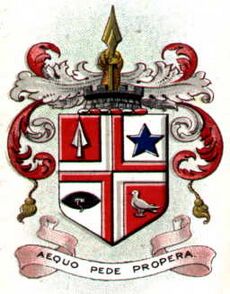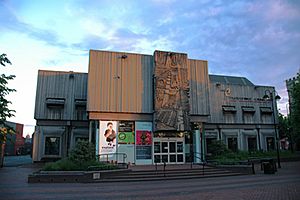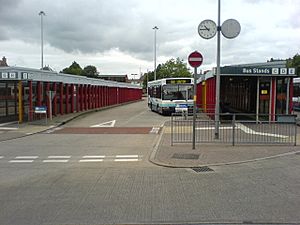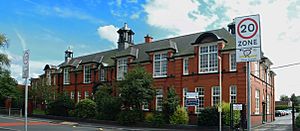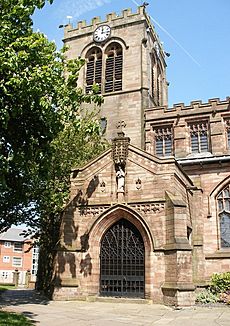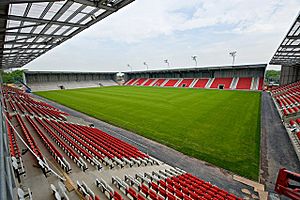Leigh, Greater Manchester facts for kids
Quick facts for kids Leigh |
|
|---|---|
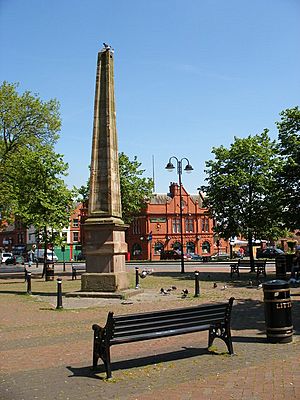 Obelisk and Michael Caines bench |
|
| Population | 41,275 |
| OS grid reference | SD655005 |
| • London | 169 mi (272 km) SSE |
| Metropolitan borough |
|
| Metropolitan county | |
| Region | |
| Country | England |
| Sovereign state | United Kingdom |
| Post town | LEIGH |
| Postcode district | WN7 |
| Dialling code | 01942 |
| Police | Greater Manchester |
| Fire | Greater Manchester |
| Ambulance | North West |
| EU Parliament | North West England |
| UK Parliament |
|
Leigh is a town in Greater Manchester, England. It's located on low land northwest of Chat Moss. Long ago, Leigh was the center of a large church area in the historic county of Lancashire. This area included six small villages or townships.
In 1875, three of these townships – Pennington, Westleigh, and Bedford – joined together. That's when Leigh officially became the name for the town. Even before this, people had called the area around the main church "Leigh" for many centuries. The town grew and became a municipal borough in 1899.
Leigh was first known for farming, especially dairy products. But over time, people started spinning and weaving at home. This led to a big silk industry and later, a cotton industry. The town also used the coal found underground, especially after canals and railways made it easier to transport goods. Today, Leigh is mostly a residential town. You can still see its industrial past in the red brick mills, but its economy now focuses on shops and businesses.
Contents
- Discovering Leigh's Past
- How Leigh is Governed
- Leigh's Location and Environment
- Leigh's Population and People
- Leigh's Economy and Shopping
- Famous Landmarks in Leigh
- Getting Around Leigh
- Education in Leigh
- Places of Worship
- Sports in Leigh
- Media in Leigh
- Culture and Fun in Leigh
- Famous People from Leigh
Discovering Leigh's Past
How Leigh Got Its Name
The name "Leigh" comes from an old English word, leah. This word meant a place in a wood or a clearing in the forest. It could also mean a pasture or meadow. In 1276, it was spelled "Legh." Other old spellings include "Leech" and "Leghthe." The area was known for its meadows and pastures. Leigh cheese, made from its dairies, was once very famous!
Westleigh means "the west clearing." Pennington's name comes from an old English word for an enclosed farm or manor. Bedford got its name from a ford (a shallow place to cross a river) called "Beda's ford."
Early Days in Leigh
We know people lived in Leigh a very long time ago. A stone axe from the Stone Age was found in Pennington. A bronze spearhead was also discovered. One Roman coin was found in Bedford. After the Romans left Britain, not much was written about Leigh. But we know Saxons were here because of place names like Leigh, Tyldesley, and Astley. These names include the old English word leah, meaning a clearing.
The Old Townships
In the 1100s, the ancient parish of Leigh was made up of six townships. These included Pennington, Bedford, Westleigh, Atherton, Astley, and Tyldesley cum Shakerley. People held weekly markets near the main church. There was also a cattle fair twice a year.
Important families lived in these townships. The Shuttleworths were landowners in Bedford from the 1300s. Their home, Shuttleworth House, is also known as Sandypool Farm. Another old manor house, Bedford Hall, is still standing today. The Sales family of Hope Carr Hall also had a lot of power in Bedford. They owned more land than the Shuttleworths for over 400 years.
The manor house of Westleigh was called Higher Hall. It existed around the time of King Richard I (1189–1199). The Pennington family owned Pennington Hall from about 1200. Later, the Bradshaw family took over. Pennington Hall was rebuilt in 1748. In 1919, it was given to the people of Leigh. It became a museum and art gallery in 1928. Sadly, it was taken down in 1963. The land is now Pennington Park.
The English Civil War
During the English Civil War, people in Leigh had different loyalties. Some supported the King (Royalists), while others supported Parliament (Parliamentarians). A battle happened in Leigh on December 2, 1642. A group of men from nearby Atherton, called Chowbenters, fought and defeated the Royalist troops.
Sir Thomas Tyldesley, a Royalist leader, was killed in the Battle of Wigan Lane in 1651. He is buried in Leigh Parish Church. The Earl of Derby, another Royalist leader, spent his last night in Leigh before being executed in Bolton.
The Industrial Revolution
At the end of the 1500s, farming was important in Leigh. But people also started spinning and weaving at home. This was a "cottage industry." Agents from Manchester would bring work to Leigh and collect the finished cloth. At first, this work helped farmers and their families earn extra money.
Leigh became known for weaving fustian, a rough fabric. By the late 1600s, special traders called "fustian masters" worked directly with weavers. They sold the cloth in Manchester.
It's believed that a local man, Thomas Highs, invented the spinning jenny and the water frame in the 1760s. These inventions greatly improved spinning. This meant handloom weavers were in high demand. But when power looms came to factories in Manchester, there was less work for hand weavers. This caused serious unemployment in Leigh.
In 1827, silk weaving started in Leigh. William Walker opened the first silk mill in 1828. Other mills quickly followed. Later, several cotton mills were built in Leigh after the 1830s. Some silk mills even changed to cotton after 1870.
The Leigth Feight happened on August 14, 1839. This was during a time of social unrest. People were upset about high unemployment and the high cost of living. A large crowd of at least 2,000 people gathered in Leigh. Workers from Chowbent threatened to burn down Hayes Mill. Soldiers were called in, and special police officers were sworn in. The Riot Act was read, and the crowd scattered for a while. But they came back later. Many people were hurt in the fighting, and some were arrested. Those arrested were punished severely. But the fight for change continued in Leigh, eventually leading to fairer voting rules.
Large spinning mills were built later. Five of these still stand today. Leigh Spinners is a very important historical building. More than 6,000 people worked in textile factories in Leigh in 1911.
Coal Mining in Leigh
People had been mining coal in Westleigh since the 1100s. But in the late 1800s, new ways of mining allowed people to dig deeper. Coal became a very important industry. After textiles, coal mining employed the most people in Leigh.
Parsonage Colliery, the last coal mine opened in Leigh, was one of the deepest in the country. It went down over 3,000 ft (900 m)! In the 1960s, mining at Parsonage Colliery grew even more. The coal seams were wet, so pumps removed water into underground canals. Then, it was pumped into the canal at Leigh.
The winding engine at Parsonage used steam, powered by gas from the mine. The nearby Bickershaw Colliery had an electric system. In 1974, the two mines were connected underground. All coal was brought up at Bickershaw because it had better facilities. Parsonage was then used for supplies. Today, all deep coal mining in the Lancashire Coalfield has stopped.
There were several mining accidents in Leigh. An explosion at Bedford Colliery on August 13, 1886, killed 38 miners. In 1932, 19 men drowned at Bickershaw Colliery after a cage fell to the bottom of the shaft.
Other Industries
Other important industries in Leigh included the tractor factory of David Brown Limited. This factory made farm machinery. Rope-making was another local industry. Mansley's Rope works made rope by hand. Anchor Cables had a large factory near the Bridgewater Canal. Another big employer was Sutcliffe Speakman, which made special carbon and brick-making equipment.
How Leigh is Governed
Leigh is part of the Metropolitan Borough of Wigan. It has three electoral areas: Leigh Central & Higher Folds, Leigh South, and Leigh West. Each area chooses three councillors to be part of the Wigan council. As of 2009, all nine councillors for Leigh were from the Labour Party.
Historically, Leigh's townships were part of the Hundred of West Derby in Lancashire. In 1875, the Leigh Local Board of Health was created. This board covered Bedford, Pennington, and Westleigh. In 1894, this area became the Leigh Urban District. It was given special "borough status" in 1899, becoming the Municipal Borough of Leigh.
In the early 1900s, many women in Leigh worked to gain the right to vote. Different groups like the Women's Social and Political Union and the National Union of Women's Suffrage Societies were active here.
In 1974, the Municipal Borough of Leigh was removed. Its land became part of the Metropolitan Borough of Wigan in Greater Manchester.
Andy Burnham was the Member of Parliament (MP) for Leigh from 2001 to 2017. He was a Labour Party politician. In 2017, he stepped down to become the Mayor of Greater Manchester. Jo Platt, also from the Labour Party, was elected as MP in 2017. However, in the 2019 General Election, James Grundy of the Conservative Party won. He was the first Conservative MP ever for Leigh.
Leigh's Location and Environment
| Weather chart for Leigh | |||||||||||||||||||||||||||||||||||||||||||||||
|---|---|---|---|---|---|---|---|---|---|---|---|---|---|---|---|---|---|---|---|---|---|---|---|---|---|---|---|---|---|---|---|---|---|---|---|---|---|---|---|---|---|---|---|---|---|---|---|
| J | F | M | A | M | J | J | A | S | O | N | D | ||||||||||||||||||||||||||||||||||||
|
70
8
2
|
70
8
2
|
50
10
3
|
63
13
5
|
51
16
8
|
58
19
10
|
54
21
12
|
69
21
12
|
63
18
10
|
88
14
7
|
82
10
4
|
79
7
2
|
||||||||||||||||||||||||||||||||||||
| temperatures in °C precipitation totals in mm |
|||||||||||||||||||||||||||||||||||||||||||||||
|
Imperial conversion
|
|||||||||||||||||||||||||||||||||||||||||||||||
Leigh is on low land. Areas to the south and east, near Chat Moss, are only about 50 feet (15 m) above sea level. The highest land, to the north and west, rises gently to 125 feet (38 m). Astley and Bedford Mosses are parts of an old bog that used to cover a large area. These are now protected nature areas.
Several streams flow through Leigh, draining into the River Mersey. The Westleigh and Pennington Brooks join other streams to form the Glaze Brook. The soil in the southeast is peaty, but most of the area has loam soil over sandstone or coal. Mining has caused some "flashes" (small lakes) to form south and west of the town. The biggest is south of the Leeds and Liverpool Canal in Pennington. Pennington Flash Country Park is a 490-acre (200 ha) park and nature reserve with a 170-acre (69 ha) lake.
Leigh is crossed by the old Bolton to St Helens Road. This was once a path for packhorses and later a toll road. The A579 road now goes around the town center. The Bridgewater Canal and the Leigh Branch of the Leeds and Liverpool Canal cross the town from west to east. They meet at Leigh Bridge, just south of the town center. In the 1930s, the A580 "East Lancashire Road" was built south of the town.
 |
Hindley | Atherton | Tyldesley |  |
| Abram | Astley | |||
| Lowton | Culcheth | Chat Moss |
Leigh's Population and People
| Leigh Compared | ||||
|---|---|---|---|---|
| 2001 Census | Leigh | Wigan MB | GM Urban Area | England |
| Total population | 43,006 | 301,415 | 2,240,230 | 49,138,831 |
| White | 98.3% | 98.7% | 90.3% | 90.9% |
| Asian | 0.8% | 0.4% | 6.2% | 4.6% |
| Black | 0.2% | 0.2% | 1.3% | 2.3% |
| Source: Office for National Statistics | ||||
In 2001, Leigh had a population of 43,006 people. About half were male (48.8%) and half were female (51.2%). There were 18,270 households. Most people (95.92%) living in Leigh were born in England.
The 2001 census also showed that most people in Leigh (85.5%) were Christian. About 7.6% said they had no religion.
In 2001, 19,051 people (44.3%) in Leigh had jobs. Many worked in shops and vehicle repair (18.36%). A lot of people also worked in manufacturing (21.60%) and in health and social care (11.99%).
| Population growth in Leigh from 1801 to 2001 | |||||||||||
|---|---|---|---|---|---|---|---|---|---|---|---|
| Year | 1801 | 1811 | 1821 | 1831 | 1841 | 1851 | 1861 | 1871 | 1881 | 1891 | |
| Population | no data | no data | 18,372 | 20,083 | 28,568 | 5,206 | 10,621 | no data | no data | 28,708 | |
| Year | 1901 | 1911 | 1921 | 1931 | 1939 | 1951 | 1961 | 1971 | 1981 | 1991 | 2001 |
| Population | 40,001 | 44,103 | 45,532 | 45,317 | 45,458 | 48,728 | 46,174 | no data | 42,929 | 43,150 | 43,006 |
| Parish 1821–1861
• Urban Sanitary District 1891 • Urban District 1901–1961 • Urban Subdivision 1981–2001 |
|||||||||||
Leigh's Economy and Shopping
Leigh has a traditional town center with daily outdoor and indoor markets. Some parts of the town center are just for walking, with local and chain stores. The Spinning Gate Centre has about thirty shops.
A retail park was built on the old Parsonage Colliery site. It's a short walk from the town center.
In 2008, the Leigh Sports Village opened. It has a stadium that can hold 12,000 people. This stadium is home to the Leigh Leopards rugby league team. It's also used by Manchester United's reserve team and their main women's team. The Sports Village also has an athletics arena, a college campus, a hotel, and other facilities for the community. In 2011, a Morrisons supermarket opened there.
Another big project is redeveloping the old Bickershaw Colliery site. This will create a country park and new homes. In 2011, "The Loom," a £50 million shopping area, opened. It has a seven-screen cinema, a Tesco Extra store, and restaurants like Nando's and Frankie and Benny's.
Famous Landmarks in Leigh
Some of Leigh's most important landmarks are the red sandstone parish church, the Leigh Town Hall, and the shops on Market Street. The Obelisk, a tall stone monument, is also here. Many buildings in the town center are made of red brick. They often have pointed gables and decorative terracotta.
Several large, multi-story cotton mills stand along the Bridgewater Canal. They remind us of Leigh's textile industry. Many are now not fully used, even though they are protected as historic buildings. Leigh's War Memorial, designed by local architect J.C. Prestwich, is a Grade II listed structure. St Joseph's Church and St Thomas's Church on Chapel Street are also impressive churches.
Getting Around Leigh
Leigh used to have good transport links, but the railway closed in 1969. Now, Leigh is one of the biggest towns in Britain without direct access to the national train network. Transport for Greater Manchester helps organize public transport in the area.
Buses
Many bus services operate from Leigh bus station. You can travel to nearby places like Wigan, Bolton, Warrington, Manchester, and St Helens. There were ideas to reopen the railway to Manchester. But instead, a special guided busway was chosen. This busway opened on April 3, 2016.
Canals
The Bridgewater Canal was extended to Leigh in 1795. In 1820, the Leigh branch canal was built. It connected the Leeds and Liverpool Canal to the Bridgewater Canal at Leigh Bridge. This gave Leigh access to many parts of Lancashire, Yorkshire, and the Midlands by water.
Railways
The closest train station to Leigh is at Atherton, about 3 miles (5 km) north. It has regular services between Wigan and Manchester. This means the bus station is Leigh's only direct public transport link.
Leigh was once the end point of the 7.5-mile-long (12 km) Bolton and Leigh Railway. This line opened for freight in 1828 and for passengers in 1831. The first train on this line was called the Lancashire Witch. The railway station was at Westleigh. The line closed to passengers in 1954 and later closed completely.
In 1861, a railway from Manchester to Wigan was built, with a branch to Leigh. The station, called Bedford Leigh, served the town. The railway crossed the town on a large bridge, which has mostly been taken down. This line closed in May 1969. After some other towns reopened their train stations, Leigh became one of the largest towns in Great Britain without one.
Trams and Trolley Buses
In 1900, a plan was approved to build over 62 miles (100 km) of tramway in southern Lancashire. The first part of the tramway opened on October 20, 1902, connecting Leigh to other towns. The company later became Lancashire United Transport. On December 16, 1933, the last tram ran from Leigh. The next day, trolley buses took over.
Education in Leigh
Leigh Grammar School existed in 1655. It moved to Manchester Road in 1931. Leigh Girls' Grammar School was started in 1921. However, both schools were closed in 1976.
Today, Leigh's high schools include Bedford High School and The Westleigh School. Students also attend schools in nearby towns like Atherton and Lowton. Wigan and Leigh College provides education for students over 16.
Places of Worship
St Mary the Virgin's Church has been in Leigh since the 1100s, or even earlier. It was once known as the Church of St Peter. The church tower, built in 1516, is the only part left from the medieval building. The rest of the church was rebuilt after it became unsafe. The current church was designed by Paley and Austin and finished in 1873. It is made of red sandstone and is a very important historic building.
Other churches have been built in the former townships. The first St Thomas's Church in Bedford was built in 1840. The current church was built in 1909. Christ Church, Pennington, was built in 1854 and is also a protected historic building. Westleigh St Paul was founded in 1847, and Westleigh St Peter, another important historic building, was founded in 1881.
The first Catholic church in Bedford was built in 1778. It was replaced in 1855 by St Joseph's Church. As more Catholics moved to the area, other churches were built, like Our Lady of the Rosary (1879) and Sacred Heart (1929). There are also places of worship for other Christian groups in Leigh.
Sports in Leigh
Leigh has a professional rugby league team called Leigh Leopards. They play in the Super League. A big moment for them was winning the 2023 Challenge Cup final at Wembley Stadium. Leigh also has several amateur rugby clubs, like Leigh East and Leigh Miners Rangers.
The town used to have a semi-professional football team, Leigh Genesis, but they stopped playing at a senior level in 2011. The most successful amateur football club is Leigh Athletic.
Leigh also has an athletics club, Leigh Harriers AC, started in 1909. There's also a Rugby Union club, Leigh RUFC. Leigh has two cricket clubs: Leigh Cricket Club and Westleigh Cricket Club.
Media in Leigh
Local news and TV shows for Leigh are provided by BBC North West and ITV Granada. Radio stations include BBC Radio Lancashire and BBC Radio Manchester. Other stations like Greatest Hits Radio Wigan & St Helens and Radio M29 also serve the area.
The local newspaper is the Leigh Journal, published on Thursdays. Other regional newspapers that cover Leigh are the Manchester Evening News and the North West Enquirer.
Culture and Fun in Leigh
Many of Leigh's old grand houses have been taken down. But their grounds are now open to the public. Lilford Park was once the grounds of Atherton Hall. It was given to Leigh in 1914. Pennington Park was the grounds of Pennington Hall.
As an industrial town, Leigh had many places for people to have fun. These included theatres, cinemas, and pubs. The Hippodrome Theatre, built in 1908, later became a cinema. Another theatre, the Theatre Royal, was on Lord Street. The Palace Cinema was built in 1913.
The old Leigh College and Library building on Railway Road was built between 1894 and 1896. The current library was built in 1971.
Leigh Hackspace was started in 2015. It's a place where people can meet, share ideas, and work on creative projects.
Famous People from Leigh
- Brian Ashton (born 1946) is a rugby union coach. He coached the England and Ireland national teams.
- Sir Alan R. Battersby (1925–2018) was a chemist who went to Leigh Grammar School.
- Thomas Burke (1890–1969) was an opera singer born in Leigh.
- Sir Peter Maxwell Davies (1934–2016) was a famous British composer and conductor.
- Kathleen Mary Drew-Baker (1901–1957) was a scientist who researched seaweed. Her work helped grow edible seaweed in Japan.
- Georgie Fame (born Clive Powell, 1943) is a rhythm and blues singer and musician born in Leigh.
- James Hilton (1900–1954) was the author of Goodbye, Mr Chips. He was born in Leigh.
- Roger Hunt (1938–2021) was a professional footballer who went to Leigh Grammar School.
- Shaun Keaveny (born 1972) is a DJ and broadcaster who grew up in Leigh.
- Lynda Lee-Potter (1935–2004) was a well-known newspaper columnist.
- Paul Mason is a journalist who was born and educated in Leigh.
- Pete Shelley (1955–2018) was a singer, songwriter, and guitarist who went to Leigh Grammar School.
- Lemn Sissay (born 1967) is a poet and Chancellor of the University of Manchester. He lived in children's homes in Leigh.
- Alfred Robert Wilkinson (1896–1940) was a soldier who received the Victoria Cross medal in World War I.
- John Woods is a former professional rugby league player and coach. He played for Leigh RLFC and holds the record for most career points. There is a statue of him outside Leigh Sports Village.




